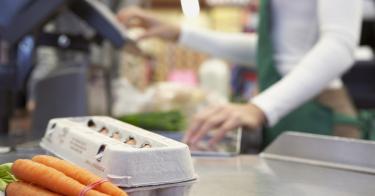Rising grocery costs continue to put the squeeze on families. Overall, the cost of a trip to fill the pantry rose nearly 22 percent since the beginning of 2021. Many specific staples rose far more—eggs are up 110 percent, flour up 29 percent, orange juice up 82 percent. A family of four spending $1000 per month just three and a half years is spending an additional $2,640 annually for this same shopping list.
Unfortunately, Vice President Harris misdiagnosed the source of the problem as “bad actors” seeing their “highest profits in two decades.” She blames the initial surge in food prices on supply chain issues during the pandemic—certainly a major contribution to the shortages and price increases on many items early in the pandemic.
However, Harris mixes this truth with falsehood by claiming businesses are now pocketing the savings after these supply-chain issues have subsided. Her proposed solution—“the first-ever federal ban on price gouging on food”—will compound the misery.
First, the faulty diagnosis. A look at the data easily counters this.
An insightful way of analyzing whether price increases are due to “gouging” is to focus on the variable production costs of the goods sold plus the selling, general, and administrative expenses. Tyson Foods—the world’s largest chicken, beef, and pork processor—aw its margin drop from 8.4 percent in 2020 to just 1.1 percent last year. Kraft Heinz and General Mills—food processors with combined revenue nearly equal to Tyson Foods, suffered similar results. Kraft Heinz’s margin declined from 21.4 percent to 20.2 percent. General Mills’s shrank from 17.8 percent to 16.8 percent. Far from “gouging,” these industry leaders are failing to fully pass along the entirety of their own cost surges to consumers. Expenses relative to sales increased during the past three and a half years of elevated inflation.
After accounting for all expenses—including extraordinary items, taxes, and interest—margins are even tighter. Notably, Tyson Foods experienced a net profit margin last year of NEGATIVE 1.23 percent. Kraft Heinz realized a 10.72 percent net profit margin last year, and General Mills a 12.91 percent margin.
What about industry-wide? Profit margins are shrinking as food manufacturing costs rose 28.4 percent since January 2020, exceeding the 26.3 percent retail price hikes on food items. Grocery store profit margins sank to 1.6 percent in 2023, the third consecutive year of decline after peaking at 3.0 percent in 2020.
In other words, grocer profit on $100 of sales is just $1.60. Profit margins contracted as overall food inflation totaled 20.6 percent in those three years. The biggest grocers have experienced this margin crunch. The Kroger Co.—the nation’s largest traditional supermarket—eked out an operating margin of 1.93 percent this past year, a margin lower now than it was pre-pandemic. These trends are the opposite of gouging.
History provides endless proof that prices set by governments under the market price results in shortages. Demand expands as supply shrinks. What good is a lower price if the shelves become empty?
Venezuela, Cuba, and the Soviet Union provide ample examples of the dangers of price controls. But the United States embarked on its own failed experiment just five decades ago. In August 1971, President Nixon ordered an initial 90-day freeze on prices and labor, with future price increases to be subject to federal approval. The proposal initially proved wildly popular, with 75 percent public support and a landslide re-election the following year. President Nixon even ordered an IRS audit on companies breaching the ceiling.
Ultimately, the program ended in disaster. As explained by Daniel Yergin and Joseph Stanislaw, “Ranchers stopped shipping their cattle to the market, farmers drowned their chickens, and consumers emptied the shelves of supermarkets.” In April 1974, the administration dismantled most of the program.
Importantly, the inflation of the early 1970s resulted largely from easy money. From the beginning of 1970 through the demise of the price-fixing program in April 1974, the M2 money supply expanded by 48 percent. In less than four years, prices rose by nearly 27 percent. In other words, prices jumped in fewer than five years by an amount equivalent to that of the entire prior decade!
Does this sound familiar? It should. The inflationary surge of the post-COVID era is largely a direct result of the explosion of government spending beginning in 2020. The Federal Reserve financed much of this spending by ginning up its digital printing presses to purchase government bonds alongside a myriad of other assets—from mortgage-backed securities to corporate debt.
The flood of new money coursed through the economy. The M2 money supply swelled by 40 percent in just two years. More dollars chasing goods and services ultimately resulted in dramatic price hikes.
Harris appears to have forgotten the important lessons from this episode. Based on her insistence that price gouging is responsible for high grocery prices—when it clearly is not—the Vice President’s proposal would more likely function as a price freeze or command pricing. As such, the existence of state laws currently prohibiting dramatic price increases during emergencies should not assuage concerns about Harris’s proposal. Of course, even these state laws may result in the unintended consequence of shortages—but these temporary interventions in the market are rarely activated.
With deficits looming even larger in the years ahead, the threat that the central bank will finance this spending with another bond purchasing spree only increases. The food production industry is not immune from the ravages of this reckless monetary policy: the spiral of rising labor costs, insurance, and equipment. In addition, the sector is particularly sensitive to the assault on affordable fuel vital to the cultivation and transportation of food.
It’s time political leaders admit their own culpability in the shrinking purchasing power of the dollar at the grocery store. Blaming painful price increases on the very entities responsible for the most bountiful, readily accessible supply of sustenance in human history is woefully misleading. Imposing price controls is a demagogic solution harmful to farmers, processors, grocers, and families.
This piece originally appeared in American Institute for Economic Research




